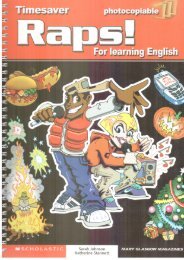English_Book_2-Teacher_300913
English_Book_2-Teacher_300913
English_Book_2-Teacher_300913
You also want an ePaper? Increase the reach of your titles
YUMPU automatically turns print PDFs into web optimized ePapers that Google loves.
Game 1 Race track• Read or call on a student to read the You needsection. Have each student choose a game piece,then a coin. You may want to bring extra coins tolend students.• Read the Useful language aloud and have the classsay it after you.• Read or have a student read aloud each of the fournumbered steps, modeling the game as you goalong. For example:1. Show your coin and ask which side is headsand which is tails. Have all students flip theircoins. Ask students who have gotten heads toraise their hands. Ask students who have tailsto raise their hands. Tell them that when theyplay the game, heads start first. Elicit how manyspaces their game piece can move if they getheads (one) and how many spaces for tails (two).2. Choose an able student to model this withyou. Tell the student that you will go first,then flip your coin. Tell the class whether yougot heads or tails and move your game piece.Elicit the cue on that space. As Player 1, thereare only two possible spaces for you to landon: sometimes or your family. Point out the Keyon the page and elicit whether you shouldask a question, make a sentence, or go back orforward one space. For example, a blue spacewith the word sometimes means you have tomake a sentence using sometimes and a yellowspace with the words your family means youhave to ask a question about your partner’sfamily. Elicit or give several possible statementsfor the cue sometimes; for example, I sometimeshave eggs for breakfast or I sometimes go bowlingon weekends. Elicit or give several possiblequestions for the cue your family; for example,Where does your family live? or Is your family intosports? Tell students that they can form eitherWh- or Yes/No questions. Point out that if aplayer makes a grammatical mistake, or, forexample, says a sentence instead of asking aquestion, he or she should go back one space.3. Have the student you are modeling the gamewith take his or her turn, eliciting the stepsthe student should take. After the student hasmade a question or sentence, elicit several otherpossible questions or sentences from the restof the class. Model the Useful language whenappropriate.4. Point out the finish line. If your class hasstudents of widely varying abilities, youmay want to tell those who finish early tostart again.• Tell students to form pairs and begin the game.Have students flip their coins to see who startsfirst. Remind them that they can continueflipping until there is a winner. As students play,go around the class, helping, monitoring, andencouraging students.TEACHER’S NOTEST22:28:12 PMPostcards_splitB_TE1_U02.indd T222/27/07 10:22:11 AM




